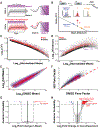A DNA repair pathway can regulate transcriptional noise to promote cell fate transitions
- PMID: 34301855
- PMCID: PMC8667278
- DOI: 10.1126/science.abc6506
A DNA repair pathway can regulate transcriptional noise to promote cell fate transitions
Abstract
Stochastic fluctuations in gene expression ("noise") are often considered detrimental, but fluctuations can also be exploited for benefit (e.g., dither). We show here that DNA base excision repair amplifies transcriptional noise to facilitate cellular reprogramming. Specifically, the DNA repair protein Apex1, which recognizes both naturally occurring and unnatural base modifications, amplifies expression noise while homeostatically maintaining mean expression levels. This amplified expression noise originates from shorter-duration, higher-intensity transcriptional bursts generated by Apex1-mediated DNA supercoiling. The remodeling of DNA topology first impedes and then accelerates transcription to maintain mean levels. This mechanism, which we refer to as "discordant transcription through repair" ("DiThR," which is pronounced "dither"), potentiates cellular reprogramming and differentiation. Our study reveals a potential functional role for transcriptional fluctuations mediated by DNA base modifications in embryonic development and disease.
Copyright © 2021 The Authors, some rights reserved; exclusive licensee American Association for the Advancement of Science. No claim to original U.S. Government Works.
Conflict of interest statement
Figures




Comment in
-
BERing transcriptional noise for cell plasticity.Nat Rev Mol Cell Biol. 2021 Oct;22(10):649. doi: 10.1038/s41580-021-00416-z. Nat Rev Mol Cell Biol. 2021. PMID: 34426687 No abstract available.
Similar articles
-
The role of the N-terminal domain of human apurinic/apyrimidinic endonuclease 1, APE1, in DNA glycosylase stimulation.DNA Repair (Amst). 2018 Apr;64:10-25. doi: 10.1016/j.dnarep.2018.02.001. Epub 2018 Feb 11. DNA Repair (Amst). 2018. PMID: 29475157
-
Modulation of the Apurinic/Apyrimidinic Endonuclease Activity of Human APE1 and of Its Natural Polymorphic Variants by Base Excision Repair Proteins.Int J Mol Sci. 2020 Sep 28;21(19):7147. doi: 10.3390/ijms21197147. Int J Mol Sci. 2020. PMID: 32998246 Free PMC article.
-
Widespread transcriptional gene inactivation initiated by a repair intermediate of 8-oxoguanine.Nucleic Acids Res. 2016 Sep 6;44(15):7267-80. doi: 10.1093/nar/gkw473. Epub 2016 May 24. Nucleic Acids Res. 2016. PMID: 27220469 Free PMC article.
-
Redox regulation of DNA repair: implications for human health and cancer therapeutic development.Antioxid Redox Signal. 2010 Jun 1;12(11):1247-69. doi: 10.1089/ars.2009.2698. Antioxid Redox Signal. 2010. PMID: 19764832 Free PMC article. Review.
-
AP Endonuclease 1 as a Key Enzyme in Repair of Apurinic/Apyrimidinic Sites.Biochemistry (Mosc). 2016 Sep;81(9):951-67. doi: 10.1134/S0006297916090042. Biochemistry (Mosc). 2016. PMID: 27682167 Review.
Cited by
-
Studying stochastic systems biology of the cell with single-cell genomics data.Cell Syst. 2023 Oct 18;14(10):822-843.e22. doi: 10.1016/j.cels.2023.08.004. Epub 2023 Sep 25. Cell Syst. 2023. PMID: 37751736 Free PMC article. Review.
-
Characterizing inhibitors of human AP endonuclease 1.PLoS One. 2023 Jan 18;18(1):e0280526. doi: 10.1371/journal.pone.0280526. eCollection 2023. PLoS One. 2023. PMID: 36652434 Free PMC article.
-
The multiple activations in budding yeast S-phase checkpoint are Poisson processes.PNAS Nexus. 2023 Oct 26;2(11):pgad342. doi: 10.1093/pnasnexus/pgad342. eCollection 2023 Nov. PNAS Nexus. 2023. PMID: 37941810 Free PMC article.
-
Biophysical modeling with variational autoencoders for bimodal, single-cell RNA sequencing data.Nat Methods. 2024 Aug;21(8):1466-1469. doi: 10.1038/s41592-024-02365-9. Epub 2024 Jul 25. Nat Methods. 2024. PMID: 39054391
-
FOXO transcription factors as mediators of stress adaptation.Nat Rev Mol Cell Biol. 2024 Jan;25(1):46-64. doi: 10.1038/s41580-023-00649-0. Epub 2023 Sep 14. Nat Rev Mol Cell Biol. 2024. PMID: 37710009 Review.
References
-
- Boltzmann L, Weitere Studien uber das Wärmegleichgewicht unter Gasmolekulen, Sitzungsber. Kais. Akad. Wiss. Wien Math. Naturwiss 66, 275–370 (1872).
-
- Arrhenius S, Über die Reaktionsgeschwindigkeit bei der Inversion von Rohrzucker durch Säuren. Z. Phys. Chem 4, 226–248 (1889). doi: 10.1515/zpch-1889-0416 - DOI
-
- Roberts L, Picture coding using pseudo-random noise. IEEE Trans. Inf. Theory 8, 145–154 (1962). doi: 10.1109/TIT.1962.1057702 - DOI
Publication types
MeSH terms
Substances
Grants and funding
LinkOut - more resources
Full Text Sources
Other Literature Sources
Molecular Biology Databases
Research Materials
Miscellaneous

